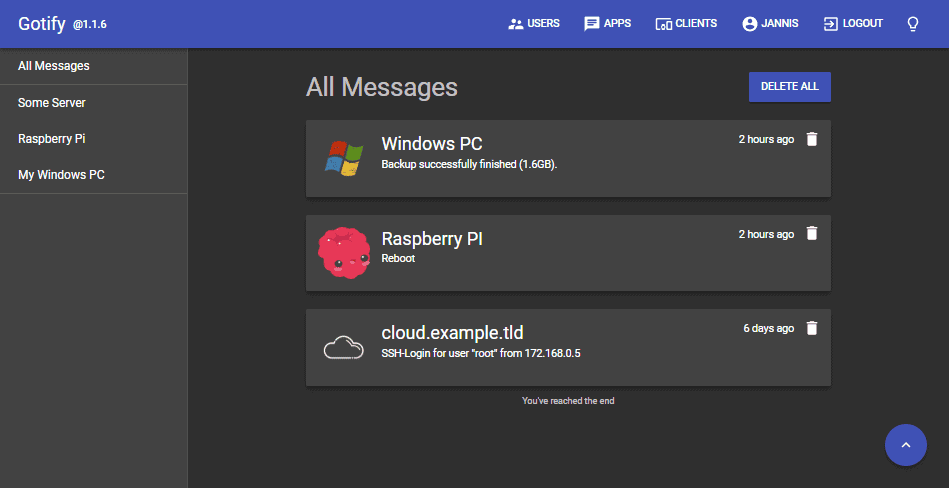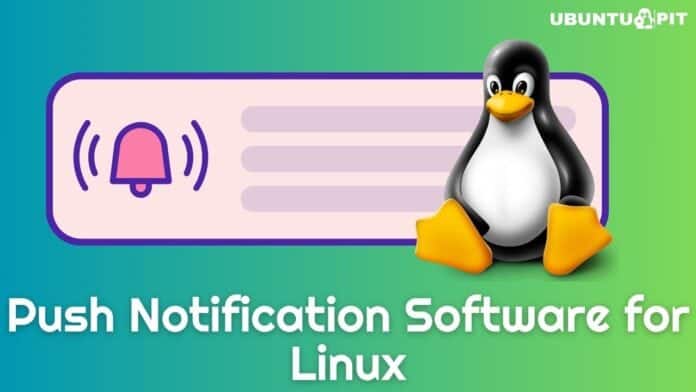Looking for the best push notification software for Linux users?
Whether you need to set alerts and reminders for yourself or send messages to your users and colleagues, push notification software can streamline that whole process. You can get notifications on mobile, laptop, and desktops, regardless of your operating system.
If you want to change your push notification tool or explore new notification software, this article will introduce you to 7 different options.
Let’s get started!
1. Dunst
 Unlike other notification daemons you see on your desktop environments, Dunst is lightweight and highly customizable. It’s fully open-source.
Unlike other notification daemons you see on your desktop environments, Dunst is lightweight and highly customizable. It’s fully open-source.
Dunst focuses primarily on user customization abilities. You can customize icons, fonts, timeout, colors, default shortcuts, etc.
You can set rules to modify the looks and behavior of different types of notifications. That means you can use various colors for messages you receive from different people. This can be useful to prioritize a message based on the color quickly.
If you want to stop getting notified temporarily, you can pause Dunst. You will receive the missed notifications later after resuming it.
The keyboard shortcuts are also useful for quickly checking the notification history or closing them. You can use your mouse too.
Recommended: 10 Best Mail Notification Tools for Linux System
Do you have multiple monitors? Dunst supports that, too. You can set which monitor to display the notification. If you want the monitor with the keyboard or mouse focus to show the messages, you can do that, too.
Dunst goes as far as to let you run custom scripts if a notification matches a specific pattern.
You can customize Dunst using the provided configuration file, dunstrc. After installing Dunst, check if it works by running the below command:
dunstify "It works"
2. Gotify
 Gotify is a simple, free, open-source server for sending and receiving messages. It’s available for multiple platforms, including Linux. It’s a self-hosted system.
Gotify is a simple, free, open-source server for sending and receiving messages. It’s available for multiple platforms, including Linux. It’s a self-hosted system.
It uses REST-API for sending messages and WebSocket for receiving or subscribing to messages. You can use the Command Line Interface (CLI), WebUI, or their Android app for messaging.
Gotify is also Docker-friendly. With every new release, you get a compatible Docker image. This can be useful for the DevOps folks.
You can use Gotify to manage users, clients, and applications.
On top of what it already offers, you can use different plugins to extend its functionality. Some of the plugin features include registering custom HTTP handlers, a YAML-based configuration system on the WebUI, one plugin instance per user, sending messages as an application, and more.
You can also configure Gotify with config files or environmental variables (preferable in the case of Docker.)
The documentation is clear and well-organized so that you can start quickly and easily.
3. Pushover
Pushover is a simple notification program for Android (including Android Wear), iOS, iPad, Apple Watch, and desktops. Setting up and getting notifications from numerous websites, applications, and services is easy.
To start using Pushover, you must get the client app on your mobile device or the web client for Google Chrome on your desktop. After creating an account, you’ll receive a “User Key” via e-mail. You can then copy and paste this randomly generated key to get notifications on your devices.
It also offers a team system where you can send notifications to multiple users and manage their devices. This simplifies sending messages to your company employees.
Another noteworthy feature is creating Delivery Groups. With Delivery Groups, you can add additional users by using a Group Key to send them messages. From your dashboard, you need to create a group and enter each member’s user key.
If you have enough technical knowledge, you can also integrate Pushover into your web apps, shell script, or network monitor using the API.
Pushover offers a 30-day free trial. After that, you’ll need to purchase a lifetime license costing $4.99. The team plan is $5 per user per month or $60 per year.
4. Yespo
Yespo is an omnichannel customer data platform that also offers mobile and web push notifications. It’s one of the most powerful notification tools on this list.
You can personalize your notifications with customer names, dynamic content blocks, selected products, and promo codes. With 180 ready-made product recommendation algorithms, you can make the best recommendations for your audience.
It also offers segmentation. You can divide your users into different groups based on their data and other conditions or parameters.
If you’re an eCommerce shop owner, Yespo can be extremely useful. You can automate your notifications for different activities, such as onboarding campaigns, abandoned cart reminders, customer reactivation campaigns, order confirmations, details, and updates.
The promo plan for web push notifications lets you send bulk messages to up to 25,000 contacts. Personalized notifications will cost 4 USD/month for up to 5000 contacts. For mobile push notifications, the starting plan costs 38 USD/Month for up to 10,000 device tokens.
5. NotifyOSD
If you’re an Ubuntu user, you’re probably familiar with NotifyOSD. It’s a passive popup notifications framework designed for Linux desktops. Ubuntu uses it by default.
Passive popups disappear automatically after a certain amount of time passes. So your workflow isn’t interrupted.
You can get notifications for instant messages, e-mails, internet connections, battery connection and condition, brightness change, volume change, and more.
There are a few notification boxes designed in NotifyOSD. There are Normal Windows, Notifications Bubbles, Alert Boxes, Morphing Alert Boxes, and Morphing Windows. Each one is for different purposes.
For example, Alert Boxes are for notifications that require input response from the user. This type of notification will contain buttons and ask you to take actions like cleaning up your disk space or reconnecting a USB device.
Morphing versions are for time-critical notifications. You should take care of these things immediately, like charging your device or picking up the call.
NotifyOSD is not as customizable as some other options in this list. But it’s simple to use and gets the job done. The real caveat is that it’s only available for Ubuntu.
6. notify-send
notify-send is a command-line desktop notification tool for Linux. It comes pre-installed on most major Linux distributions.
notify-send uses the command line notification daemon to send notifications on your desktop. These can remind you of any events or display essential, timely information.
To install notify-send, you can follow the below commands for the different distributions:
sudo dnf install libnotify # Red Hat based distributions sudo apt install notify-send # Debian based distributions sudo pacman -Sy libnotify # Arch based distributions
Sending notifications with this tool is quite simple. Open the terminal and execute the below command:
notify-send <Enter message in double quotes>
So if you want to send the message “Hello World”, all you have to do is run the below command:
notify-send "Hello World"
You can add another argument to the command as a body text of the notification, like this:
notify-send "Even Reminder" "Office meeting at 10 PM"
You can also set urgency levels for your notifications. You have 3 options: critical, normal, and low. To pass an urgency to the command, follow the below format:
notify-send -u critical "Security Alert" "Your computer has been hacked"
You can also customize the expiration time and use custom icons with your notifications.
7. UnifiedPush
Another free and open-source option is on the list. UnifiedPush is not like any other push notification software here. It’s rather a collection of specifications and tools that allows you to pick the method to deliver push notifications.
You have multiple implementations and servers to choose from. They offer several applications you can install on your device which they call “Distributors.” The distributor receives the notifications and further distributes them to other devices.
You have ntfy, Conversations (XMPP), or UP-FCM Distributor for non-self-hosting options and NextPush as a self-hosting plan.
Then, you have a “Push Server” that listens for upcoming notifications. Once you connect the distributor to the push server, you can start getting notifications.
Currently, they don’t have any support for Apple devices.
Finally, Insights!
We all have to deal with notifications every day. Having suitable software that meets all your needs can change how you use them.
Whether you want to send notifications to your users, employees, and customers or need it for yourself, push notifications software for Linux will make it easy never to miss an alert.
Do you listen to podcasts on your Linux device? Check out the best podcast apps for Linux.
